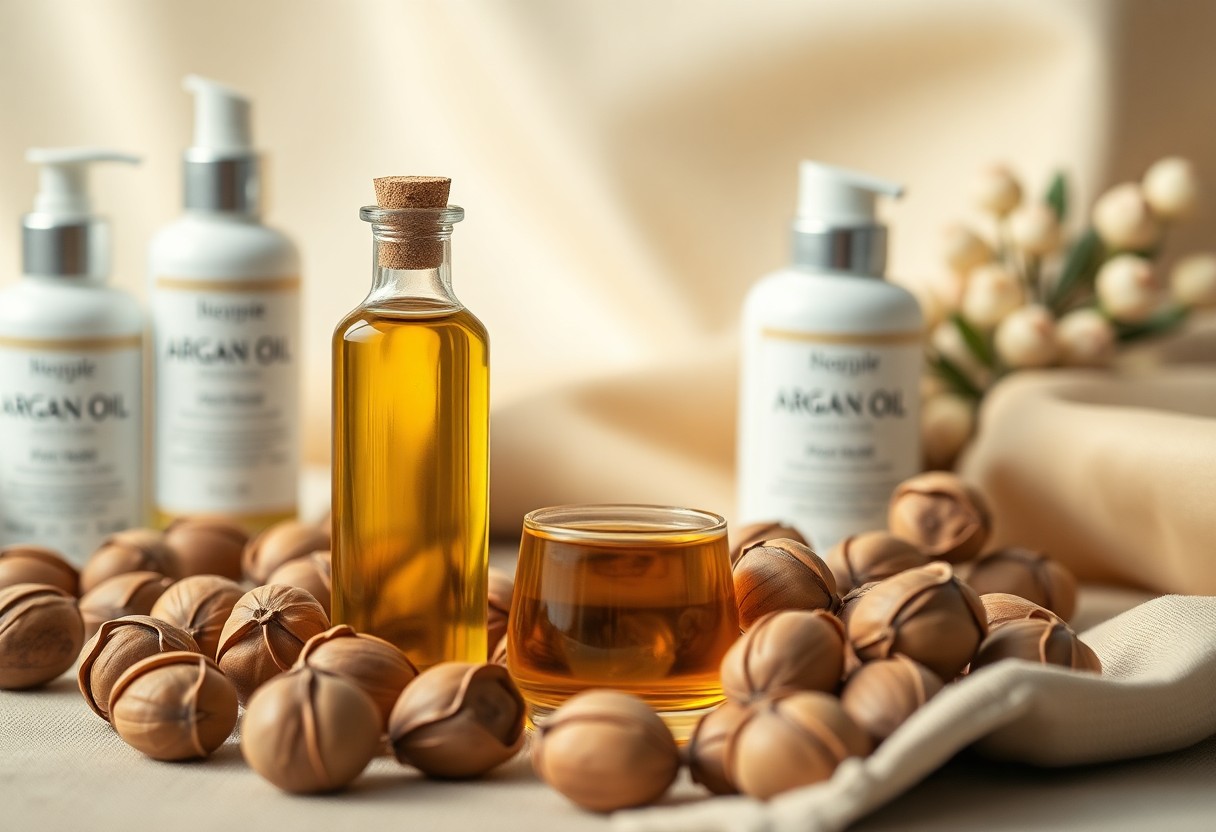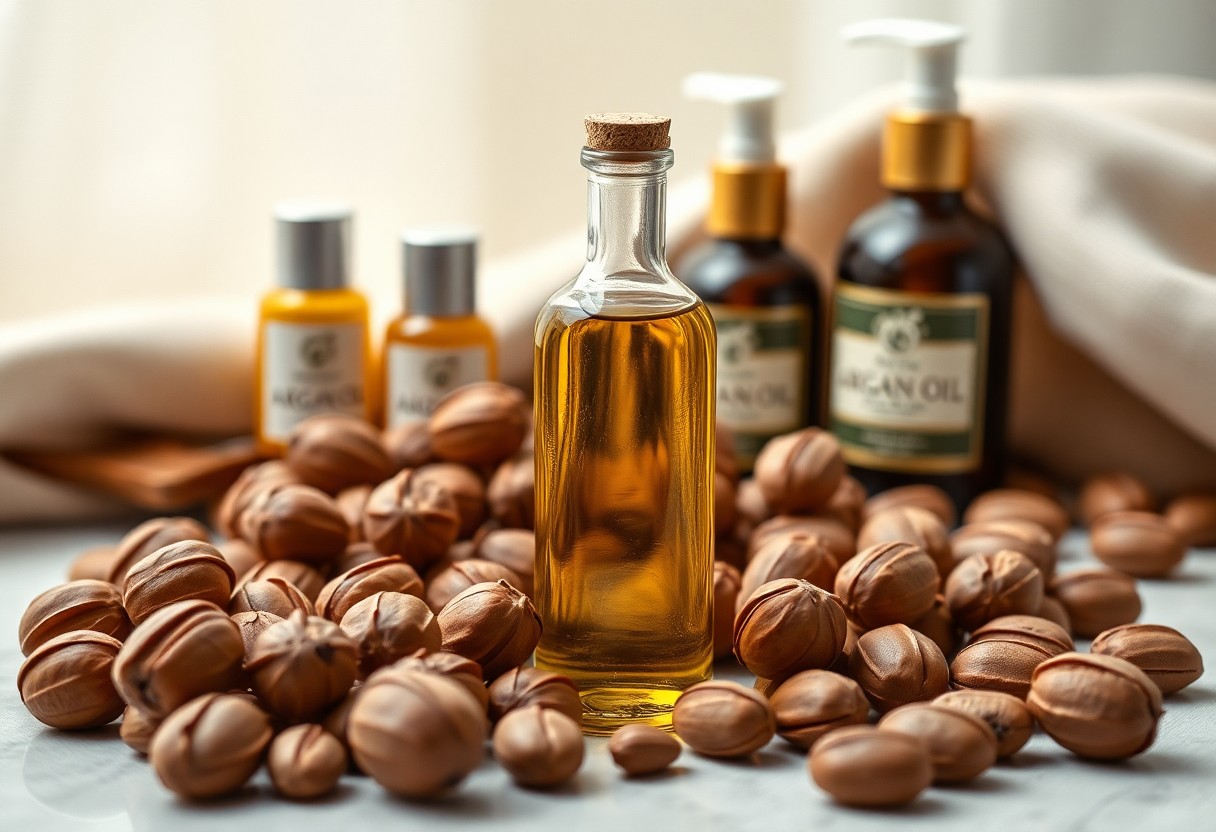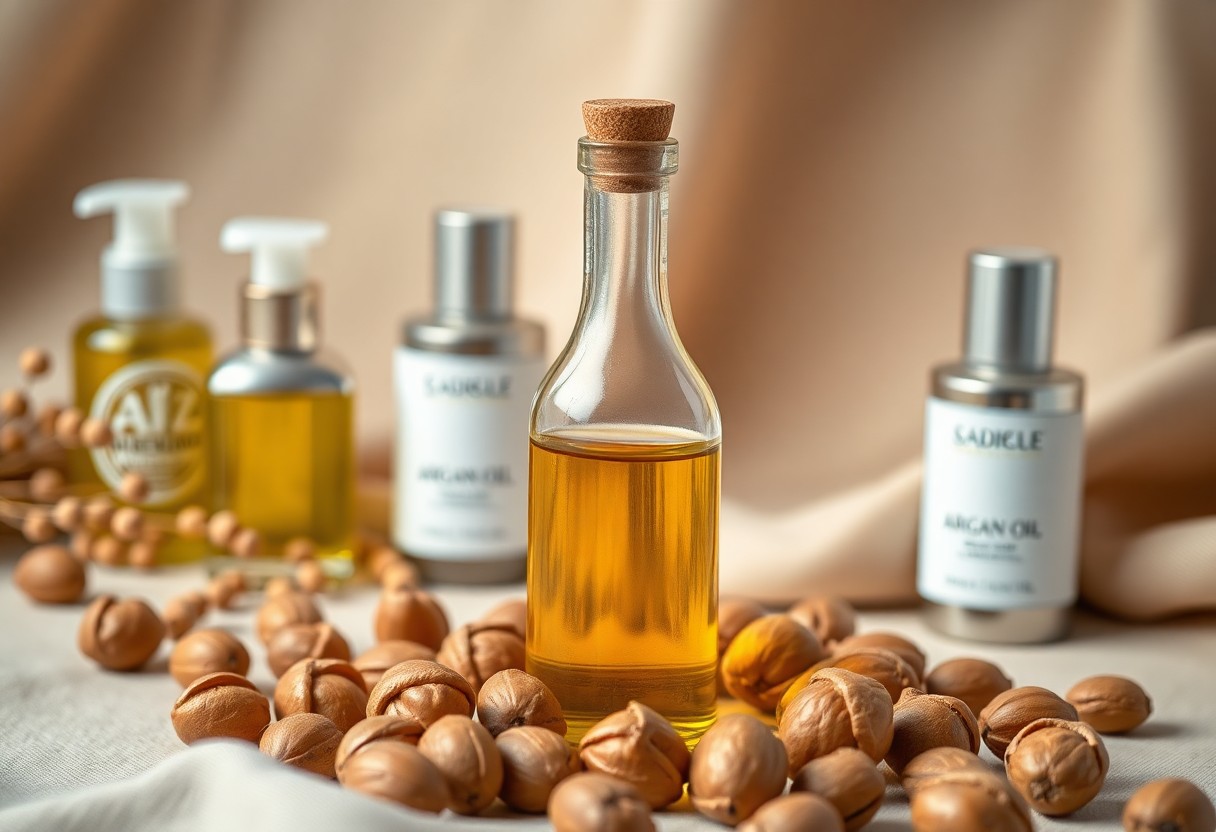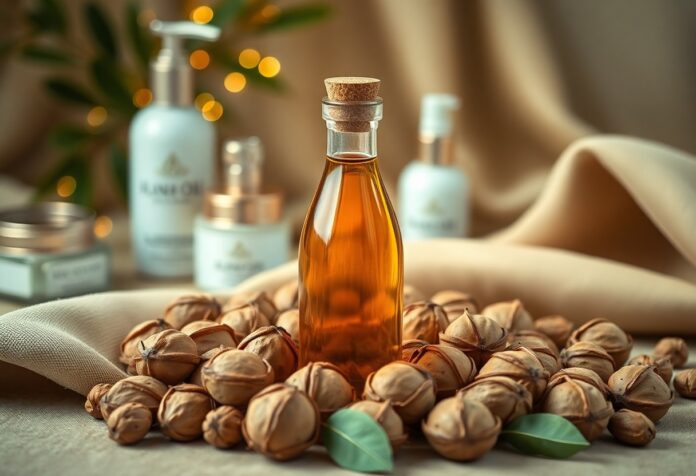Over the past few decades, the beauty industry has witnessed a remarkable shift towards natural ingredients, and argan oil stands out due to its exceptional emollient properties. You might be surprised to learn how incorporating argan oil into your cosmetic formulations can enhance hydration and improve skin texture. This versatile oil not only offers nourishment but also has the potential to revolutionize your approach to skincare and beauty products. Explore how you can harness the power of this golden elixir to create transformative formulations for your beauty routine.
Key Takeaways:
- Moisturization: Argan oil is rich in fatty acids and vitamin E, which provide deep moisture, making it an excellent ingredient for hydrating cosmetic formulations.
- Skin Barrier Protection: The emollient properties of argan oil help to strengthen the skin barrier, reducing transepidermal water loss and enhancing overall skin health.
- Anti-Aging Benefits: With its antioxidant properties, argan oil helps to combat the signs of aging, promoting a youthful appearance in skincare products.
- Non-Greasy Feel: Unlike some heavier oils, argan oil absorbs quickly into the skin, providing nourishment without leaving a greasy residue, making it ideal for cosmetic use.
- Versatility: Argan oil can be used in various cosmetic formulations ranging from creams and lotions to hair care products, enhancing their texture and performance.
How to Understand the Emollient Properties of Argan Oil
While delving into the emollient properties of argan oil, it becomes evident that this remarkable oil possesses the ability to soften and moisturize your skin and hair. This natural gem, derived from the nuts of the argan tree native to Morocco, is rich in crucial fatty acids and antioxidants, which contribute to its significant emollient characteristics. As you consider incorporating argan oil into your cosmetic formulations, it is crucial to comprehend how these properties can enhance skin hydration, improve texture, and provide a protective barrier against environmental stressors.
Tips for Identifying Quality Argan Oil
Properties of high-quality argan oil are indicative of its potential benefits in cosmetics. When deciding on argan oil, keep these tips in mind to ensure you’re investing in a product that offers the best emollient properties:
- Look for cold-pressed argan oil, as this extraction method preserves its nutrients.
- Check for certifications that verify its purity and organic status.
- Review the color and scent; authentic argan oil is a golden yellow and has a nutty aroma.
- Investigate the source, favoring brands that emphasize sustainable harvesting practices.
Recognizing these quality indicators not only ensures that you access the full benefits of argan oil but also supports ethical sourcing practices.
Factors Influencing the Efficacy of Argan Oil in Cosmetics
Assuming you’re well-informed about the emollient capabilities of argan oil, it’s time to explore various factors that could influence its efficacy in cosmetic applications. The concentration of fatty acids, particularly oleic and linoleic acids, can significantly affect how your skin absorbs and utilizes the oil. Furthermore, the formulation in which argan oil is incorporated plays a vital role; its compatibility with other ingredients can enhance or diminish its effects. Here are several elements to consider:
- Temperature and storage conditions may alter the oil’s properties.
- The synergistic effects of other cosmetic ingredients can either enhance or impede its performance.
- Individual skin types and conditions can influence how well argan oil is absorbed, highlighting its tailored use.
Thou, as you experiment with argan oil in various formulations, may discover its remarkable adaptability and potential to enrich your skincare or cosmetic experience.
Efficacy of argan oil in cosmetic formulations is also shaped by its oil quality and the extraction method. Unfiltered or unrefined oils might retain more nutrients but could be less stable over time, while refined oils may lack some of their natural benefits. You should take note of specific formulations and their intended targets; argan oil may provide different results in a moisturizer compared to a lip balm. Its impact can be maximized by combining it with other beneficial ingredients. Here are more factors to consider:
- Regular usage patterns influence overall effectiveness.
- Testing personal tolerance to the oil can reveal its suitability for your individual skin.
- The method of application can dictate how effectively your skin absorbs its emollient benefits.
Thou must align your cosmetic endeavors with an understanding of these factors for optimal utilization of argan oil’s emollient properties.
How-to Incorporate Argan Oil into Cosmetic Formulations
Clearly, incorporating argan oil into your cosmetic formulations requires a systematic approach to ensure the best results. As you explore this rich ingredient, consider reviewing Argan Oil: Chemical Composition, Extraction Process, and … for a comprehensive understanding of its properties. Begin by assessing the formulation’s overall synergy; argan oil can provide excellent moisturization, but matching it correctly with other emollients and active ingredients is imperative to avoid an excessive oily feel. Aim for a balanced texture that aligns with the product’s intended use, whether it be creams, lotions, or serums.
Tips for Balancing Argan Oil with Other Ingredients
To fine-tune your formulations, utilize the following tips for achieving that balance:
- Start with small amounts of argan oil and gradually increase to find the ideal ratio.
- Pair argan oil with lighter oils, like jojoba or grapeseed, to maintain a non-greasy texture.
- Incorporate emulsifiers that work synergistically with argan oil to enhance stability.
Knowing how to balance argan oil with the right components will ultimately elevate the effectiveness and sensory experience of your formulation.
Factors to Consider When Formulating with Argan Oil
Consider the following imperative elements when crafting your product with argan oil to optimize its performance:
- Evaluate the oil’s fatty acid profile to decide how it complements your formulation’s desired functionality.
- Understand the viscosity of argan oil to match it with appropriate emulsifiers for a smooth application.
- Analyze the stability of your product over time, as argan oil may influence its shelf life.
Recognizing these factors will empower you to create sophisticated formulations that leverage argan oil’s unique benefits while ensuring overall efficacy.
Plus, being informed about these considerations unlocks further opportunities for creative experimentation. These might include:
- Testing variations of oil blends to achieve specific textures and benefits.
- Exploring the thermal stability of your formulation to prevent any degradation of active compounds.
- Incorporating other ingredients with similar emollient characteristics to amplify results.
Recognizing the multifaceted nature of formulation dynamics allows you to exploit the full potential of argan oil and significantly enhance the quality of your cosmetic products.
How to Maximize the Benefits of Argan Oil for Different Skin Types
After understanding the fundamental properties of argan oil, you can effectively tailor its application to suit your unique skin type. Here is a table outlining how different skin types can harness the full potential of this versatile oil:
| Skin Type | Tips for Use |
|---|---|
| Oily | Use sparingly; mix with a light moisturizer to control shine. |
| Dry | Apply directly or blend with heavier creams for deep hydration. |
| Combination | Focus on drier areas, customizing your routine with other oils. |
| Sensitive | Patch test before use; can be diluted to minimize reactions. |
| Normal | Incorporate as part of your daily routine, for a balanced look. |
Perceiving the diverse requirements of your skin will allow you to integrate argan oil effectively into your regimen. For more insights about The benefits of argan oil on the skin, explore tailored tips that resonate with your specific skin condition.
Tips for Customized Cosmetic Solutions
One way to create optimal cosmetic solutions is to blend argan oil with other beneficial ingredients that cater to your skin’s unique needs. This approach can enhance hydration, combat aging, or reduce inflammation, depending on your desired outcome. Here are some suggestions for combinations:
- Mix with Vitamin E for enhanced anti-aging effects.
- Add necessary oils, like tea tree, for acne-prone skin.
- Combine with aloe vera for soothing and hydrating properties.
- Incorporate hyaluronic acid for an extra moisture boost.
- Blend with shea butter for a rich, nourishing cream.
The evolving landscape of cosmetic formulations welcomes your creativity and needs in maximizing the benefits of argan oil.
Factors Affecting Skin Compatibility with Argan Oil
Some factors play a pivotal role in how well your skin may react to argan oil, influencing its efficacy and outcomes. Consider the following elements:
- Your skin’s overall health and condition can change how well it absorbs oils.
- The presence of any skin conditions, like eczema or rosacea, warrants careful consideration.
- Your skin’s oil production levels may dictate how much argan oil is needed.
- Environmental factors, such as climate, can alter your skin’s hydration levels.
- Your overall diet and hydration status can greatly affect skin texture.
After assessing these influencers, adjustments in your application of argan oil can be made to ensure compatibility and desired results.
With an understanding of your skin’s unique characteristics and needs, you can become your own innovator, crafting personalized solutions informed by your intuitive understanding of how your skin operates. Each factor contributes to the larger puzzle of skin compatibility with argan oil, guiding you toward a more effective routine.
- Having patience is necessary as your skin adjusts to new products.
- Monitor for any allergic reactions, as individual responses can vary.
- Consult with a dermatologist if uncertain about product use.
- Maintain a balanced skincare routine to support your skin’s health.
- Experiment with different formulations until you find your ideal match.
After exploring various dimensions of skin compatibility with argan oil, consider it an evolving journey that invites discovery and personal expertise.

How to Educate Consumers on the Benefits of Argan Oil
Unlike many synthetic alternatives, argan oil is revered for its rich content of fatty acids and antioxidants, which contribute to its emollient properties. To effectively educate consumers about the advantages of this exceptional oil, you must articulate its origins, the traditional methods of extraction, and its transformative impact on skin and hair. By positioning argan oil as a natural solution, you can cultivate a narrative that resonates with your audience’s growing interest in holistic beauty practices. Sharing testimonials or scientific studies demonstrating its efficacy will further underscore its credentials and appeal to discerning consumers.
Tips for Effective Marketing Strategies
Marketing strategies should revolve around the authenticity and sustainability associated with argan oil. Highlight its Moroccan heritage and the cooperative efforts that empower local communities. Utilize visually appealing packaging and informative labeling that emphasizes organic, fair-trade credentials. Consider the following tactics to drive your campaigns:
- Leverage social media platforms to share user-generated content.
- Create educational blog posts or videos that discuss the benefits of argan oil.
- Engage with beauty influencers who are passionate about natural ingredients.
Any effort made towards promoting argan oil must reflect a genuine commitment to sustainable practices and the wellbeing of consumers.
Factors Driving Consumer Demand for Natural Ingredients
You may have observed a noticeable shift in consumer demand for natural ingredients, particularly in the beauty and skincare industry. This evolution is propelled by a profound awareness of the adverse effects of synthetic components and an increasing preference for eco-friendly products. As you analyze the factors driving this surge, consider the importance of transparency in sourcing and formulation. Consumers are increasingly seeking products that align with their values, and natural ingredients are often perceived as safer and more effective alternatives. These preferences pave the way for an opportunity to present argan oil as not just another ingredient, but as a cornerstone of sustainable beauty.
- Heightened awareness of the benefits of clean beauty.
- Growing interest in holistic health and wellness.
- A desire for eco-friendly and cruelty-free products.
Argan oil, with its rich history and multifaceted benefits, perfectly aligns with these evolving consumer trends. By presenting consumers with the scientific backing and ethical standards associated with argan oil, you are helping them make informed choices that contribute to their overall wellbeing. Perceiving the oil in this light can enhance its desirability and integrated use in daily beauty regimens.

How to Evaluate the Sustainability of Argan Oil Sourcing
Despite the growing popularity of argan oil in the cosmetic industry, it is vital for you to evaluate the sustainability of its sourcing. Ethical sourcing not only ensures that the environment is preserved, but it also supports local communities that depend on the argan tree for their livelihoods. For instance, How argan oil became a haircare hero – Ingredients outlines how the harvest process can impact both ecological balance and local economies. Therefore, as a conscious consumer, you must pay attention to how the argan oil you buy is produced to ensure that your beauty choices contribute positively to the world around you.
Tips for Ethical Sourcing Practices
With the desire to make informed choices, you should consider implementing ethical sourcing practices in your product selection. Look for brands that can provide transparency about their supply chain, ensuring that the argan oil is sourced from cooperatives that respect the rights of women and indigenous people. Also, consider the following:
- Check for certifications that guarantee eco-friendly practices.
- Investigate the brand’s partnerships with local communities.
- Evaluate whether the company contributes to the conservation of argan forests.
Recognizing these elements will empower you to make choices that benefit both your wellbeing and the planet.
Factors Impacting Sustainability in Argan Oil Production
With increasing demand for argan oil, several factors impact its sustainability. Overharvesting poses a severe threat to the delicate argan ecosystem, jeopardizing the tree’s long-term survival. Additionally, climate change is exacerbated by deforestation, which has far-reaching effects on biodiversity. You should also consider whether the production methods employed are eco-friendly. The degree to which local communities are involved in the harvesting process affects not only their economic welfare but also the preservation of traditional techniques that support sustainable practices. It’s vital to assess the following:
- Climate conditions affecting argan tree growth.
- The rate of harvesting per year.
- The methods of extraction used to ensure minimal environmental impact.
Thou must remain conscious of these factors to ensure that your consumption supports sustainable practices.
Understanding the intricate dynamics of argan oil production can guide your purchasing decisions significantly. The ecosystem surrounding the argan tree is fragile, and as climate change progresses, it may threaten not only the trees but the livelihoods of communities that depend on them as well. The following aspects are worth considering:
- Farming techniques that reduce land degradation.
- Community engagement in sustainable practices.
- Management of water resources to minimize usage.
Thou must be diligent in your research to aid in protecting this invaluable natural resource.

How to Stay Ahead of Trends in Cosmetic Formulation
Many beauty brands aspire to stay relevant in the ever-evolving landscape of cosmetic formulation. Keeping an eye on emerging trends and customer preferences is crucial for your business to thrive. To achieve this, you must embrace innovation while continuously updating your understanding of consumer needs and desires. Engage with your audience through social media, surveys, and focus groups to gauge what resonates with them. This interaction provides valuable insights that could lead to the development of next-generation products.
Tips for Innovating with Argan Oil
Formulation with argan oil can elevate your cosmetic products, providing them with desirable emollient properties. Consider integrating argan oil into various product types, such as creams, serums, and lip balms. To inspire your creative process, here are some tips to keep in mind:
- Experiment with different blends of oils to find the perfect texture.
- Utilize argan oil in conjunction with other natural ingredients for enhanced benefits.
- Conduct solid research on argan oil’s sustainability and sourcing practices to appeal to environmentally conscious consumers.
Recognizing the unique advantages of argan oil can set your formulations apart, capturing the attention of your target audience and boosting your brand’s reputation.
Factors Shaping the Future of Cosmetic Ingredients
Even the landscape of cosmetic ingredients is constantly shifting, influenced by factors such as technology, sustainability, and consumer awareness. As consumer demand grows for transparent and ingredient-driven formulations, understanding these dynamics will help guide your product development. Here are some factors to keep in mind as you innovate:
- The shift towards clean beauty and non-toxic skincare.
- Rising interest in sustainable sourcing and ethical practices.
- Technological advancements in ingredient extraction and formulation processes.
Knowing these factors allows you to make informed decisions that will appeal to a broader audience, helping your brand stay relevant in a competitive market.
Howto navigate the complexities of cosmetic ingredients requires an adaptable mindset and a proactive approach to research. Today’s consumers are not just looking for appealing packaging; they demand efficacy and integrity in their beauty products. Keeping abreast of regulations and scientific advancements will enable you to position your brand favourably. Consider these additional points:
- The impact of social media on ingredient transparency and consumer choices.
- Shifting regulations and guidelines regarding product safety and labeling.
- Emergence of new natural and organic ingredients responding to market demands.
Knowing these aspects enables you to create innovative formulations that align with the values of today’s consumers, establishing a sustainable future for your brand in the cosmetic industry.
Summing Up
With these considerations, you begin to recognize the transformative potential of argan oil’s emollient properties in cosmetic formulations. As you investigate deeper into the molecular interactions between your skin and this extraordinary oil, you can appreciate how its unique composition not only hydrates but also aids in restoring the skin’s natural barrier. It opens up avenues for innovative products that cater to a variety of skin types, potentially revolutionizing your beauty routine and enhancing the efficacy of everyday cosmetics.
Furthermore, as you explore the implications of incorporating argan oil into formulations, you may ponder the interplay between nature and science. This divine synergy, much like the elements that govern our universe, could lead to breakthroughs that satisfy both aesthetic desires and biological needs. In doing so, your understanding of skincare will evolve, compelling you to embrace a future where beauty is synonymous with natural nourishment—prompting a paradigm shift in how we view cosmetic ingredients and their role in our daily lives.
FAQ
Q: What are the emollient properties of argan oil?
A: Argan oil is rich in fatty acids and vitamin E, making it an excellent emollient. Its fatty acids, primarily oleic and linoleic acid, help to hydrate and soften the skin by forming a protective barrier that locks in moisture. This barrier also assists in improving the overall texture of the skin, promoting a smooth and supple feeling. Because of its lightweight nature, argan oil absorbs quickly into the skin without leaving a greasy residue.
Q: How can argan oil enhance the effectiveness of cosmetic formulations?
A: By incorporating argan oil into cosmetic formulations, products can benefit from its deep hydration and skin-repairing properties. This oil can improve the penetration of other active ingredients, thanks to its emollient nature, ensuring that they work more effectively. Additionally, argan oil’s antioxidant properties can contribute to better skin health, counteracting signs of aging and providing a more youthful appearance, which makes it a valuable addition to various cosmetic products.
Q: In what types of cosmetic products is argan oil commonly used?
A: Argan oil is versatile and can be found in a wide range of cosmetic products, including lotions, creams, serums, hair oils, and lip balms. Its ability to moisturize and nourish makes it an ideal choice for facial and body formulations. Additionally, it is often included in products aimed at repairing damaged hair, promoting shine, and reducing frizz, highlighting its multifunctional benefits in different beauty industries.
Q: What benefits does argan oil offer for different skin types in cosmetic formulations?
A: Argan oil is beneficial for all skin types due to its lightweight and non-comedogenic properties. For dry skin, it provides necessary hydration and helps to restore the skin’s natural moisture barrier. For oily or acne-prone skin, argan oil can help balance sebum production while still delivering hydration, preventing the skin from becoming overly oily. Furthermore, its anti-inflammatory properties make it suitable for sensitive skin, calming irritation and redness.
Q: Are there any sustainability considerations regarding the use of argan oil in cosmetics?
A: Yes, sustainability is an important factor when it comes to sourcing argan oil. The production of argan oil is closely tied to the argan tree, which is native to Morocco and plays a vital role in the local ecosystem. Ethical sourcing practices, such as supporting local cooperatives and ensuring fair trade, are necessary to promote sustainable harvesting methods. This not only protects the argan tree and its environment but also supports the livelihoods of local communities involved in its production, making argan oil a responsible choice for cosmetic formulations.

